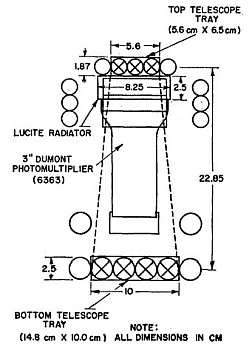Purpose of the flight and payload description
The objective of the flight was to measure the intensities of the low-Z components of the primary cosmic radiation at balloon altitudes using a thin Cerenkov detector placed within the solid angle of a Geiger counter telescope.
The core of the apparatus was formed by the Cerenkov detector which consisted of a Lucite block optically coupled to a photomultiplier tube. The Cerenkov detector was placed between the two trays of a Geiger counter telescope whose axis was vertical. Finally the guard counters were arranged according to the figure at left. The electronic circuitry was such that if a particle passed through any of the guard counters simultaneously with a telescope coincidence the corresponding Cerenkov output pulse was "marked". Shower detection was accomplished in the following manner: if two or more counters in either the bottom or the top tray were triggered simultaneously the associated circuitry was such that the corresponding Cerenkov output pulse was "marked" in a manner similar to that for a guard count.
The pulses from the photomultiplier were amplified by a pair of 4 tube "pulse shaping" feedback amplifiers. Pulses from particles with Z < 2 appeared in the linear region on the CRT (cathode-ray tube) attached to the high-gain amplifier while those pulses from particles with Z < 5 appeared in the linear region on the CRT attached to the low-gain amplifier.
A continuous record of events was made by photographing the traces that appeared on the CRTs using a camera whose shutter was always open and the 35-mm film moved past the lens continuously at the rate of 6 feet per hour.
The entire apparatus was enclosed in a pressure tight aluminum gondola. The total weight of the apparatus when ready for flight was 95 pounds.
Details of the balloon flight
Balloon launched on: 2/12/1954 at 14:00
Launch site: Goodfellow Air Force Base, San Angelo, Texas, US
Balloon launched by: Winzen Research Inc.
Balloon manufacturer/size/composition: Zero Pressure Balloon Winzen - 90.2 ft diameter
Balloon serial number: 90-2x100-V-67
Flight identification number: WRI 345
End of flight (L for landing time, W for last contact, otherwise termination time): 2/12/1954
Balloon flight duration (F: time at float only, otherwise total flight time in d:days / h:hours or m:minutes - ): ~ 8 h
Landing site: Near Lampasas, Texas, US
Payload weight: 95 pds
Overall weight: 560
External references
- Determination of the Intensities of Low-Z Components of the Primary Cosmic Radiation at Lambda=41° Using a Cerenkov Detector Physical Review, vol. 100, Issue 5, pp. 1460
- Flight Summary Log Winzen Research Inc. report (1963)
If you consider this website interesting or useful, you can help me to keep it up and running with a small donation to cover the operational costs. Just the equivalent of the price of a cup of coffee helps a lot.


